
Low-maintenance perennials are a busy gardener’s best friend!
For starter, perennials come back year after year (as opposed to annuals that only survive one season). And these low-maintenance varieties require very little attention to THRIVE — especially once they are established.
I also love that after a few years, perennials are usually big enough to split, which means I quickly get double and triple the number of plants for a smaller initial investment.
I’ve saved myself loads of time and money by focusing on low-maintenance perennials, with a few higher-maintenance pops of color throughout.
And our yard looks fantastic all season long!

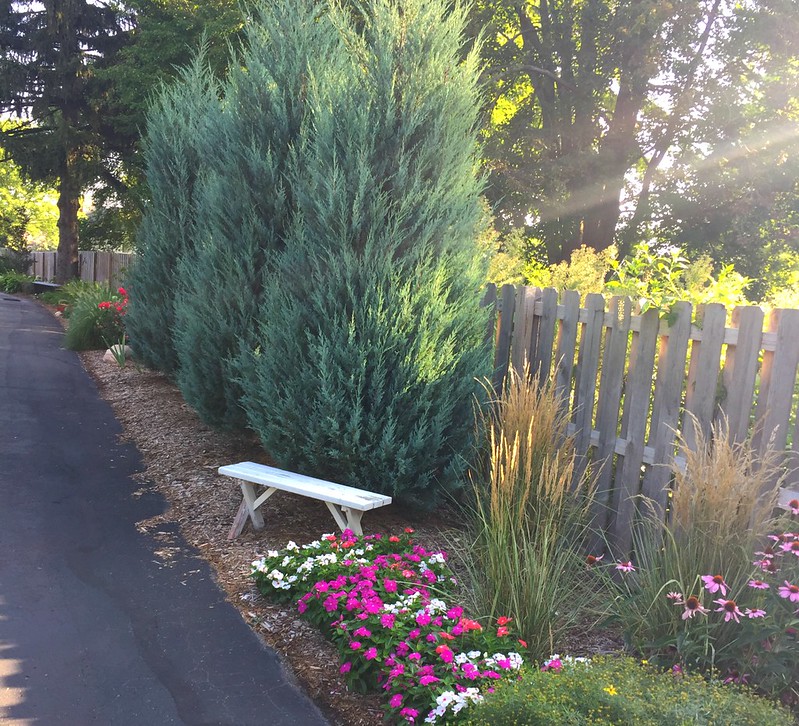
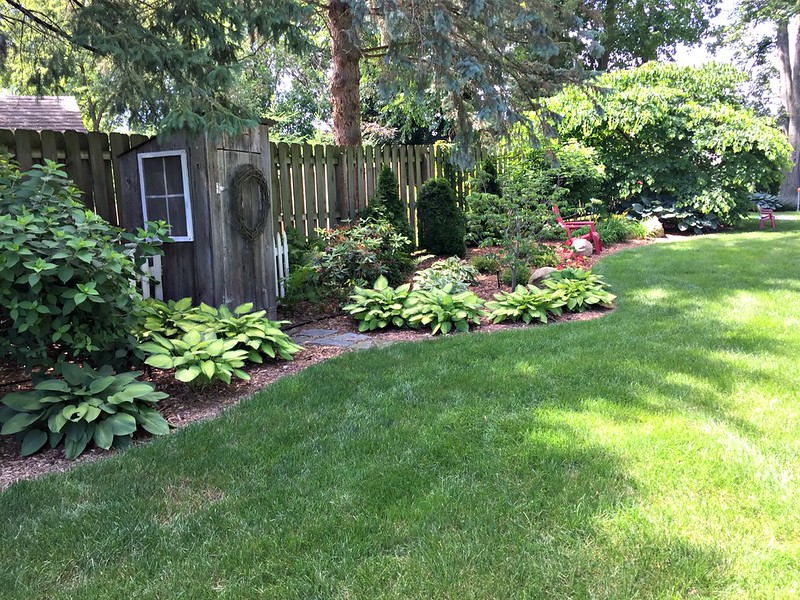

If you’re interested in starting a low-maintenance garden this year, here are some of my favorite low-maintenance perennials for sun and shade.
My favorite low-maintenance perennials for sun:
1. Double Blooming Knockout Roses
I know, you probably don’t think Roses are “low maintenance” but I’m here to tell you THEY ARE!
We have roughly 40 Double Blooming Knockout Rose bushes around our property and the ONLY thing we need to do to maintain them is to hack them back in the fall.
That’s it!
They bloom CONTINUOUSLY from May through October and look gorgeous all spring, summer, and fall.
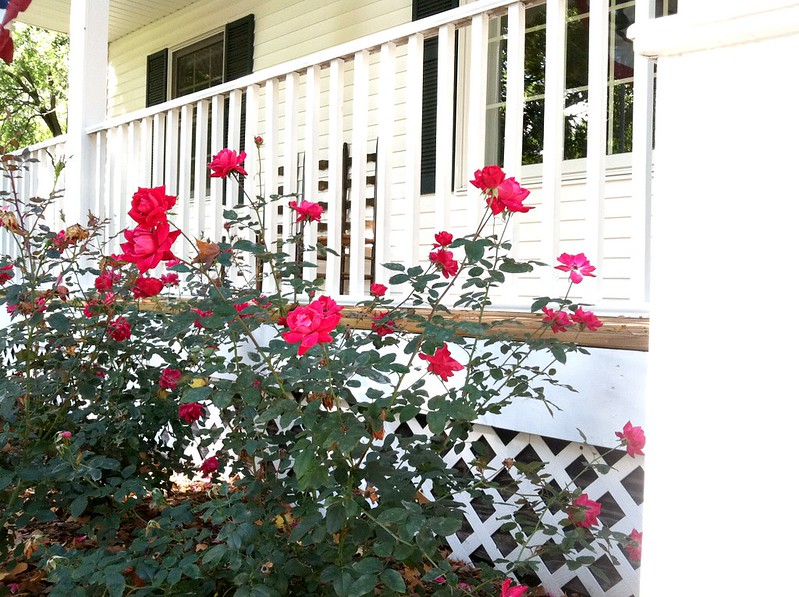
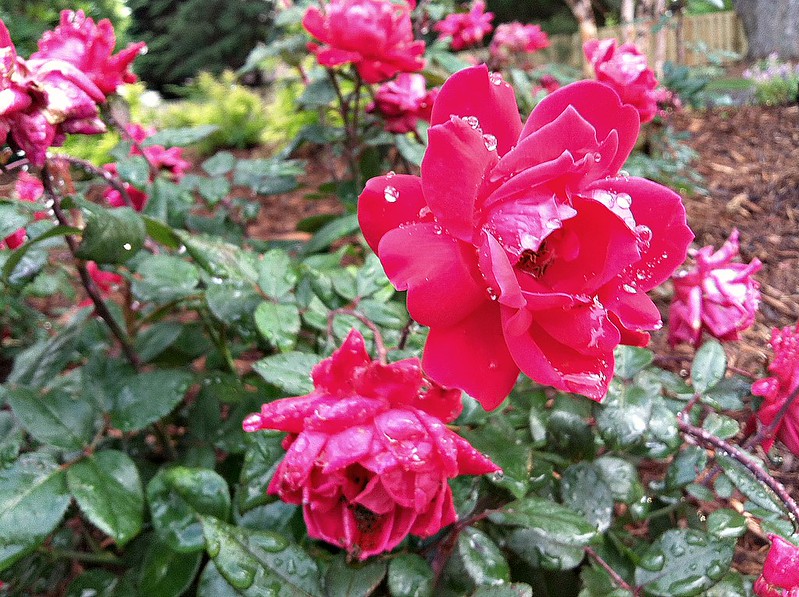
2. Sedum
Sedum is quite possibly the easiest perennial to grow (at least where we live).
It’s similar to a succulent, so it’s practically drought-tolerant.
Sedum also has fabulous year-round appeal because the “blooms” dry out and look great all winter long. I often cut some of the bright green stems for spring bouquets and then use the darker dried blooms for fall and winter bouquets.
One of my favorite varieties is Sedum Autumn Joy — it turns sort of crimson red in the fall. SO pretty!

3. Iris
I absolutely love Bearded Iris — specifically the miniature purple flowers (although my sister has tons of yellow and they are pretty too!)
Iris are very easy to grow, they look amazing in large clusters or in small bunches as accents, and they are fantastic as cut flowers to bring inside!



4. Dianthus
Dianthus are low-growing, almost ground-cover-like perennials and produce cascading “carpets” of tiny flowers.
Our Firewitch Dianthus perennials are the very first flowers we see in the spring. They continue blooming throughout the spring and then again in the fall.
If you need the perfect pop of color, give Dianthus a try!

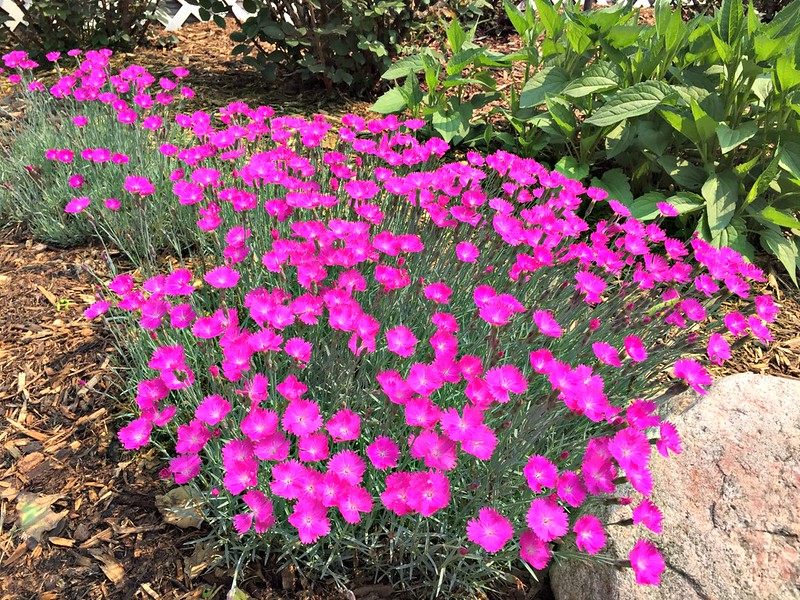
5. Black-Eyed Susans
Personally, I feel like Black-Eyed Susans just scream “country farmhouse” to me!
I’ve always loved these bright yellow flowers, and have made a point to plant them in several places throughout our landscape (including a big patch right by our front door).
Black-eyed Susans do spread quickly — so keep that in mind if you want to plant them in a very contained area.
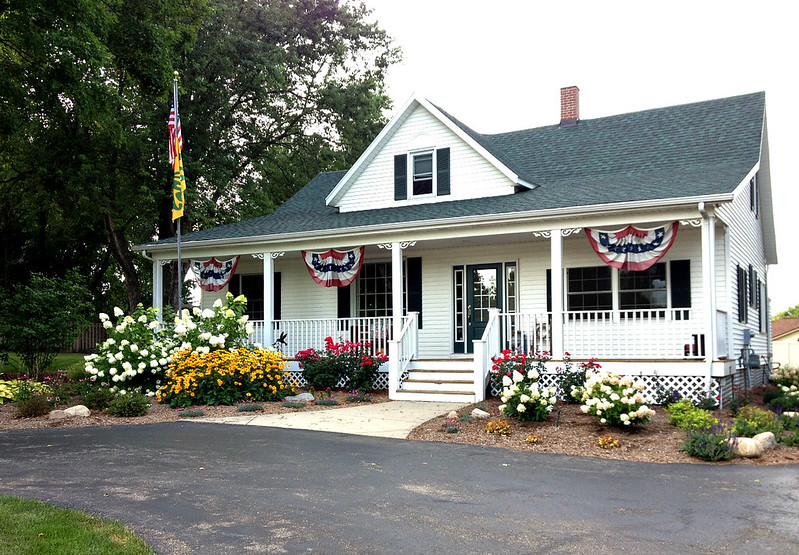

My favorite low-maintenance perennials for shade:
1. Hostas
Hostas are probably the easiest shade perennial to grow — it’s almost impossible to kill them!
They don’t get a great flower, but they have fantastic green/white/blueish foliage from early spring through late fall, which makes them a great “filler plant” for your perennial beds.
Many varieties will tolerate a fair amount of sun, but the leaves stay darker green in the shade.
If you’re looking for hostas, search Craigslist or Facebook Marketplace first — people are ALWAYS getting rid of sections of Hostas they split off.

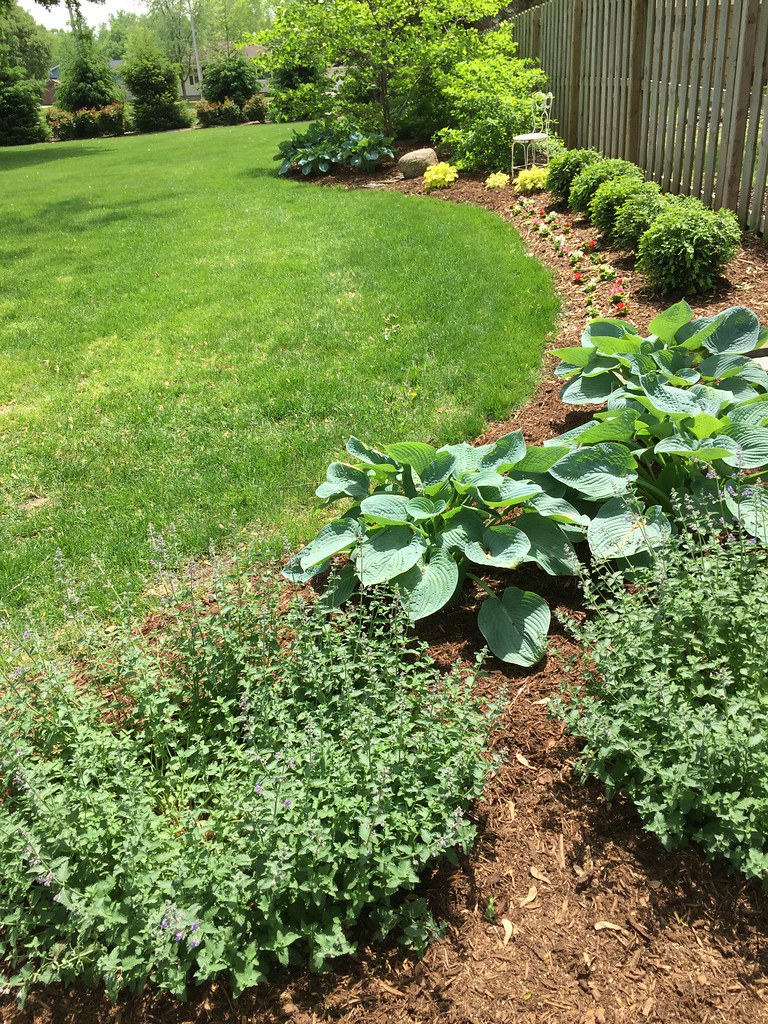
2. Ferns
I LOVE ferns!
They do spread quickly, but I personally use them mainly for “filler” or foundation plantings to cover fence lines or the base of buildings.
Of course, Boston Ferns make great hanging baskets… and Asparagus Ferns are SO fun (just make sure you keep them in a pot as they spread like crazy!)
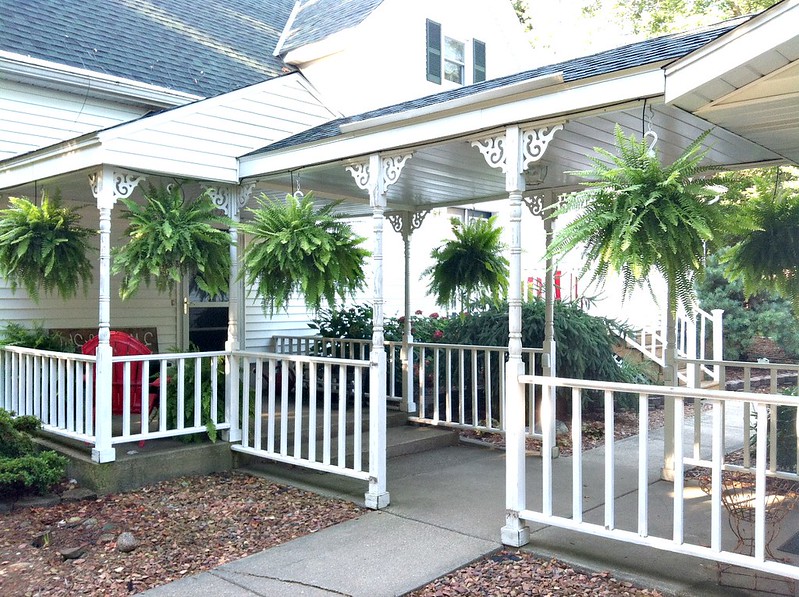

3. Hydrangeas
Hands down, hydrangeas are my all-time favorite flower… ever!
We may have gone a bit crazy with them — I think we planted close to 50 over the past 6 years. They just look SO fantastic all year long!
Plus, I love using the dried blooms to decorate with during the winter months.
If you want a hydrangea that can tolerate quite a bit of sun, try the Limelight Hydrangea.

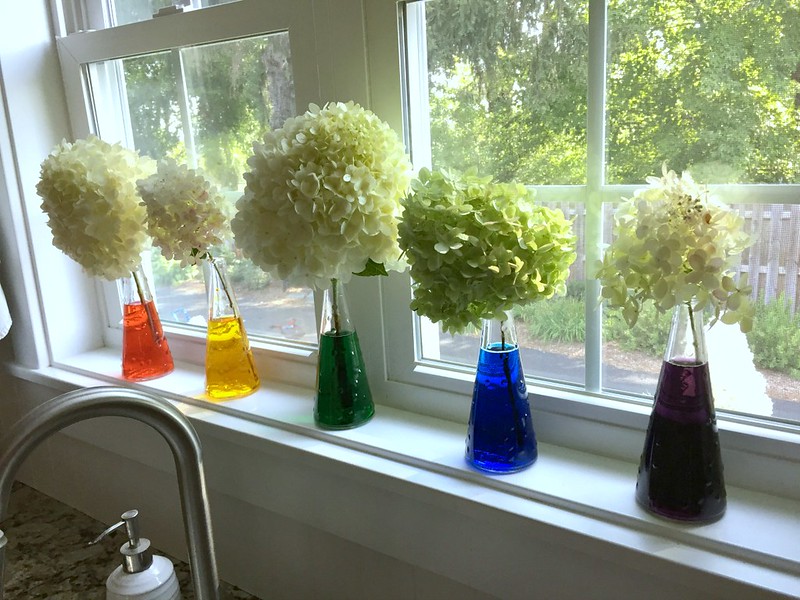
4. Purple Coneflower
The Purple Coneflower is another perennial that just oozes country charm.
Similar to the sun-loving Black-Eyed Susan, the Purple Coneflower spreads quickly, so it’s great for large areas.
It’s also an excellent cut flower to add bright pops of color to any bouquet.

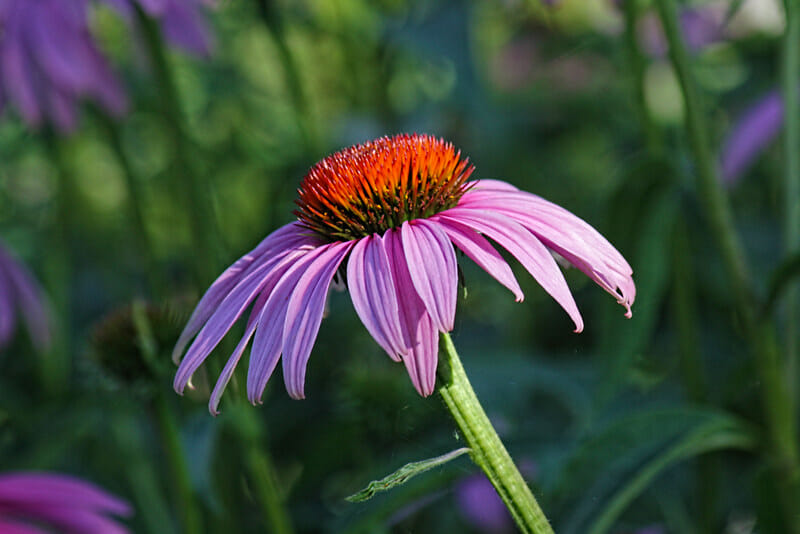
5. Bleeding Hearts
Bleeding Hearts were the very first “plant gift” I ever got.
After we moved into our old house, a plant-savvy neighbor stopped by and gave me a small Bleeding Heart plant.
I was amazed by how pretty it was when it bloomed and knew I wanted to incorporate more into our landscaping.
Fast-forward 15 years, and we now have several clumps of Bleeding Hearts tucked away in various shady planting beds.
They are the very first shade-loving perennials to bloom in the spring… and they are the first plant I need to cut back in the fall. Other than cutting them back in the fall, they require no other maintenance!

If you’re like me and love the LOOK of beautiful flowers without all the maintenance, pick up a few of these low-maintenance perennials the next time you’re at the greenhouse!
Related Reading:
- a complete list of all the plans in our landscape
- all my landscaping posts (including all our big renovation projects)
- how we keep weeds out of our planting beds
- a few tips to grow gorgeous green grass
What are your favorite low-maintenance perennials?
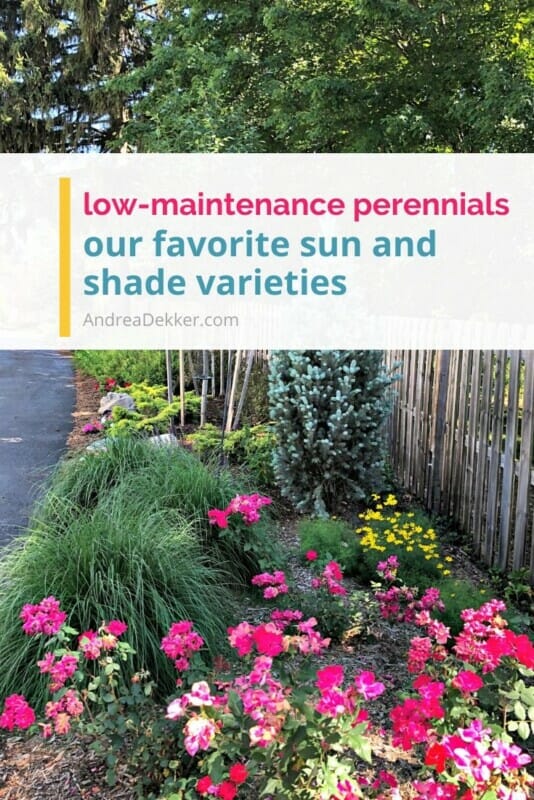

Jean says
Thanks for sharing your favorites. Your landscaping is nothing short of spectacular. Now that you have a dog I bet you are training the dog not to snack because some of the plants are toxic or cause stomach issues. The challenge is real!
Andrea says
Yeah, Buster has been a bit of a pain — he loves to eat grass (which makes him sick) so it’s a bit annoying to take him outside right now. Hopefully he will outgrow his infatuation with grass clippings 🙂
Karen Weger says
A great inexpensive way to get perennials is to buy the clearance plants at your local box stores.
Andrea says
Yes, great tip Karen!
Pascale says
Hello Andrea,
We are invaded by maple seedlings. They are in all our landscape areas, flower beds, peninsulas and under and around each one of our trees. So far I have spent at least 20 jours if not more on my knees pulling them out and they keep multiplying and germinating everywhere. For health reasons, I refuse to put herbicides, pesticides or chemicals to get rid of them. Do you have any suggestions?
Teresa says
Great article. I’m printing and taking to Lowe’s and my local nursery with me. LOL!
Love the tip about checking Craig’s List and Facebook MarketPlace.
Andrea says
yes, definitely look for “cast offs” on Facebook and Craigslist — I’ve found so many plants for free that way!
Faith Semien says
Thank you so much for the advice. My yard is screaming for attention. I love the flowers that come back year after year. Now, I have a list to bring to the nursery with me. Awesome!
.
Andrea says
happy to help, Faith!
Pixie508 says
Our big issue is deer! Our area has been over run, and the deer destroy everything, even things that should be deer resistant. It’s so sad, because I at one point had beautiful landscaping, but they killed my hostas, roses, and so many other things you listed. About the only thing they haven’t destroyed is lilies, black eyed susans, hydrangea, rhododendron, and iris, and daffodils. Plus we have two big burning bushes that they leave alone. It’s been trial and error. I plant stuff and see if they destroy it, if they do, I move on to the next thing. I just bought some bleeding heart bulbs to plant this spring.
Andrea says
oh man — that’s so sad 🙁
We thankfully are not affected by deer! I’m glad you can still do the hydrangeas — those are my personal favorites!
Good luck with the bleeding hearts!
Natalie says
Hello Andrea,
Thank you for sharing these ideas. Very helpful.
I was wondering about the Boston ferns in your hanging baskets. They look great! Do you have to throw them out during winter and buy new ones every summers?
Thank you,
Natalie
Andrea says
you’re welcome, Natalie!
the Boston ferns do not winter over in Michigan (and I personally don’t choose to bring them inside). However, we have other ferns that are planted in the ground and they come back every year.
Amy Downing says
For the shade plants, do these all work ok under pine trees? Do you have any specific plants for planting under pine trees, other than hostas?
Andrea says
Many of them work well under pine trees. Keep in mind that pine needles create very acidic soil, so some plants like that more than others!
JJ says
Oh, your garden is so beautiful!!! I had an amazing garden at our last home for almost free due to my dad giving me clippings and portions of his plants. I was 9 months pregnant and just couldn’t do the transplanting with also having a 1 and 2 year old to chase after. But I love to look back at pics.
My favorite perennials that aren’t listed are: Lamb’s Ears, Wandering Jew, Daylilies(my husband’s uncle breeds them and can create and register a “new” breed with your own name!), and Portulaca(they are technically annuals but will come back every year “in the right environment”. My father-in-law has some from his parents(who have been deceased for over two decades) that come up every year and had been transplanted from another state. Andrea, I also love hostas and roses!!! We are trying to expand our rose garden(he-hem… one bush as of now, haha!).
Andrea says
that’s awesome — I got TONS of plans for free over the years too! It’s so fun to get free plants 🙂
Barb says
Do you have to cut the dianthus back after they finish blooming in the spring in order for them to bloom in the fall again?
Andrea says
I don’t cut it back. It sometimes gets a little brown but always seems to come back!
Becky says
I have most of what you’ve listed!
I also LOVE Columbine. They come in a million colors and styles, grow with no help from me wherever I plant them, reliably self-sow, and bloom multiple times per year.
Andrea says
I love Columbine too! We had a bunch at our old house but none at this house.
Kimberly Norris says
Can crhysanthimum and hydrangeas take full sun all day?
Andrea says
mums… yes. Hydrangeas… it depends on the type. They usually prefer at least some shade, but we have several Limelight hydrangeas that can tolerate full sun.
Also, it depends on where you are located, what your climate is, and what your gardening “zone” is. You’ll probably want to look into all of this too.
Ron Wagner says
Rose of Sharon, Janes Magnolia, and Forsythia have been the big winners for me. In other words they flourish even though my soil is mostly oak mold, and not the good soil I used to have in a normal Central Illinois property. We have 100 year old Burr Oaks, which create a lot of shade in most spots so I have to work around them, looking for the sunniest spots. Fruit trees are my other priority and I have fifteen young ones, most still in cages to protect against deer. The above are all low on the edible priority for deer also. The fruit trees need to be caged for deer protection though, as does the vegetable garden, except for tomatoes and potatos.
Christina says
My list would look nearly identical! We too have just moved into a new house and are excited to see what is coming up around us. We had SOOOO many hostas at the last house but none here. I can’t wait to adopt some from my friends and bring them home! Thanks for your great advice.
Claire says
I love flowering shrubs because you can bring some of them inside and force them as a sort of prelude to spring. My favorite was ornamental quince, in coral or red; pussy willow; forsythia; climbing hydrangea, one variety of which is evergreen; sweet autumn clematis. Also had weigela, mock orange and a lovely, early blooming buttercup winter hazel. Witch hazels provide color in off season. Edgeworthia or paper bush have 4-season interest and amazing fragrance. Camellias are gorgeous if planted in the proper conditions. In Portland, OR I saw varieties that grew as high as the roof line. Depending on your space, these may not even require pruning. A whole hedge-like row in spring has amazing visual impact.
Liz @ Love Grows Wild says
Thank you for sharing! I have never had much of a green thumb, but we’re moving into a new house and I can’t wait to get started planting some blooms! Low maintenance is perfect for me!
Allison says
Hi Andrea! I really enjoy reading your blog. You’ve got great ideas. 🙂
I live in the deep South and my favorite perennials for this part of the country are:
agapanthus, amaryllis, day lilies, ferns, hostas (must put in deep shade!), hibiscus, salvia, snapdragons, echinacea, black-eyed susan, blue daze, calla lily, canna lily, blanket flower, blue plumbego, sunflowers, shasta daisy, gerber daisy, iris, to name a few!
~Allison
Debra Kapellakis says
I enjoyed this very much. thank you
Jenni / Life from the Roof says
This was really really helpful. I think the first time I ever came to your site was from a link to the “top ten things we don’t spend money on,” and even then I was impressed by what you had done with your landscaping. We are in our first home (pseudo-owned – we rent, but it’s from our in-laws, so we have more freedom) and I have never done landscaping before, so I’m going to keep these in mind for what we could do. We have a hydrangea bush in our backyard, but it isn’t blooming right now. I’d love to do more in the front like you did to add some pep to the facade.
It is amazing what can be accomplished in 4 years – thanks for sharing these pictures!
Brooke says
Andrea-
As usual your before/after photos of your hardwork are incredibly inspirational (not to mention motivating!).
I have a few questions regarding your first home.
It is fairly similar in style to the home in which we are renting at the moment (and will be until summer 2013, when we believe we’ll be “ready” (is one every truly ready?) financially to purchase a home).
However, with that said, even though this is not our forever home – nor even “our” home (another topic for another day, as I believe while we are living here, it is our home – and I enjoy taking care of it as if it really were our own home…), I like it to feel comfortable & be able to take pride in the home in which we are living. Of course, we don’t want to invest too much financially in things that we won’t be able to bring with us when we move.
Having a nice yard & yes, some curb appeal is important to me.
So – my question(s)….
In your first home it looks like there was an “overhang” on the left side next to the garage (front of house). We have an “overhang”, and when we first moved into this home it was just filled with rocks, brush (looked gross), and it’s right next to the front door.
The 1st summer we lived here (2010), we were able to convince (not without a TON of effort on our part) to at least have new bark put in. That looked great for the summer – yet, now coming upon 2 years later, the bark is done (we have a LOT of neighborhood cats who love to use this space as their litter box – yes, disgusting!).
So – I’m fairly certain the landlords are not going to go for another dump of bark (& I’m thinking that is just a bad idea, with the cat situation anyways).
Like I said, it has an overhang, is next to our front door, as well as next to the sidewalk leading to our front door & we have a big window in our living room directly above this “mess of an area”.
Due to the overhang & location it gets very little sun – so planting prob isn’t an option.
My thoughts have been to level out the bark that is there & using pavers – just make it into a “larger” front porch area – however, that goes against my husbands feelings of investing in a home that isn’t technically ours.
Sorry this is so lengthy!
Any help/suggestions/thoughts from you or any other readers would be SO APPRECIATED!
This area has been a thorn in my side since the day we moved in & I’m just at a loss of what to do. I do know, that I can’t stand it being the neighborhood litter box any longer!
Ann says
River rock would be an option but would cost $.
You could plant myrtle or another creeping plant that thrives in shade to cover the area.
If you pour vinegar in the area periodically, the cats will leave it alone.
I wonder if you put down pavers if you could take them with you when you go?
Brooke says
Ann –
Thanks for the tip regarding vinegar. I have learned that vinegar, baking soda and olive oil can do just about anything! (alone, mixed together, etc.).
We could potentially take the pavers with us, I’m sure… yet, I have no idea if we would need them at our new home. And… honestly, the owners of our home don’t seem to care much about the “curb” appeal of the house… so I had decided whatever we do (as we’ve GOT to do SOMETHING!) that it would stay with the house, for the next renters or buyers. We do have a Habitat for Humanity Re-hab Store close by, and I was thinking of stopping in over there, to see if they have any inexpensive pavers… and now, thinking to see if they have any river rock. As I know purchasing that retail, would be a bit too spendy.
I’ve never thought of planting something. Honestly, I think the whole area would need to be resoiled ????? And, it is a fairly big area…. I think prob. approx. the size of what it looks like Andrea’s front (1st home) is/was.
However, I’m open to anything at this point. I guess it’s now a matter of finding the supplies that are not too expensive, and of course, deciding what I’d like to go with… I do really like your idea of river rock… it would look really nice in the space.
Thanks again!
Demaroge says
You could try a small water-feature (the non-permanent kind,) or make it a decorative spot … like a small wheelbarrow, a milking bucket, a wagon wheel, a Gnome picnic area …. you get the idea. Just shop at your thrift stores a bit and see what you find that is your ‘style’ of creative.
If it is a small enough area to dump rocks there; that would be better than the bark (it wouldn’t need replaced) and maybe you could even get the landlord to pitch in for it because it would be more permanent; especially if it would eliminate the litter box. Certainly they would want the litter box gone!
Also ….. sometimes you can get plants from sweet neighbors (or even strangers!) who have plants they need to split. I have seen websites for people who have plants to share. Also, I have even just gone up and asked someone when I saw a huge area of Tiger Lilies and they were happy to give some if I did the work. (Those wouldn’t work in the shade but Star Lilies do.)
Demaroge says
Oh, and the house may not be yours … but it IS your Home. 🙂
Julie says
You could try planting hostas. Perhaps someone is willing to split theirs. They do fill in pretty fast. As far as soil goes,perhaps just add fresh soil and mix in the holes that you would plant. Just a thought. Another thought I just had was…google plants that cats don’t like and see if there are some inexpensive you could plant.
Margaret says
Phlox is nice, especially the kind that grows about a foot and a half tall. They’re hardy, non-invasive and a pretty green plant with little flowers on top. And the greenery lasts from late spring to early fall. Creeping phlox is also good, but doesn’t grow well where I live. If you have something you want to cover up, turn to the Virginia Creepers. They grow like crazy. Pig squeal is a fun border plant, little pink flowers on a spike (a big version of hyacinths?). And I’ve had good luck with Delphiniums, although they can be a little finicky. Good luck!
Melody says
I also love Lily of the Valley! They multiply and spread like crazy and look amazing with ferns!
Also, what is the small pink plant in the corner of the picture with Sedum?
Beth says
I have a row of hostas in front of our porch and I agree – they are so low maintenance and are great fillers! Plus after a couple years they are usually large enough to split and you can use them to fill in somewhere else without having to buy anything new!
My very favorite flower is the hydrangea! My husband worked in landscaping and golf course maintenance for years when he was younger and knows a lot about how to treat the soil so you can get different color blooms. It all has to do with the pH (is what he tells me!).
Demaroge says
Maybe giving your hydrangeas leftover (cooled!) coffee and/or coffee grounds would change the ph. Baking soda and vinegar have opposite ph values … but I don’t know if they would work. Just thinking ‘out loud’ here. 🙂
KJ says
I love my irises and lilies… I also have chrysanthemums and gladiolus, both easy-care perennials.
Heather says
Also LOVE hydrangeas! Did you know you can change the color of them by adding chemical to the soil? Pretty cool flower, I don’t know any other flowers you can change their color!
One flower that I enjoy is Purple Coneflower. it is drought resistant and low maintenance! I have mine planted by my Black Eyed Susans and they really compliment each other!
Demaroge says
Purple Coneflower is also known as Echinacea. it is gorgeous with the Susans! Love your combination, Heather!
Lauren K. says
I have several of the ones you mentioned, in addition to azaleas (LOVE!), tulips and hyacinths. Those are all pretty low maintenance for me, plus they came with the yard!
Julie @ The Family CEO says
I have many of the plants on your list. I especially love hostas. We have a huge tree line in our yard and were going to plant ground cover underneath, but we’ve decided on a ton of hostas instead.